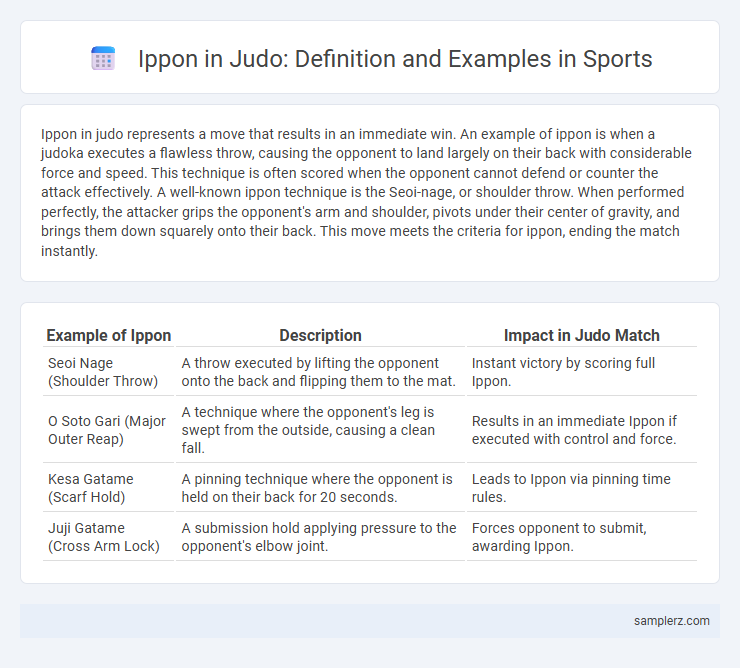Ippon in judo represents a move that results in an immediate win. An example of ippon is when a judoka executes a flawless throw, causing the opponent to land largely on their back with considerable force and speed. This technique is often scored when the opponent cannot defend or counter the attack effectively. A well-known ippon technique is the Seoi-nage, or shoulder throw. When performed perfectly, the attacker grips the opponent's arm and shoulder, pivots under their center of gravity, and brings them down squarely onto their back. This move meets the criteria for ippon, ending the match instantly.
Table of Comparison
| Example of Ippon | Description | Impact in Judo Match |
|---|---|---|
| Seoi Nage (Shoulder Throw) | A throw executed by lifting the opponent onto the back and flipping them to the mat. | Instant victory by scoring full Ippon. |
| O Soto Gari (Major Outer Reap) | A technique where the opponent's leg is swept from the outside, causing a clean fall. | Results in an immediate Ippon if executed with control and force. |
| Kesa Gatame (Scarf Hold) | A pinning technique where the opponent is held on their back for 20 seconds. | Leads to Ippon via pinning time rules. |
| Juji Gatame (Cross Arm Lock) | A submission hold applying pressure to the opponent's elbow joint. | Forces opponent to submit, awarding Ippon. |
Defining Ippon in Judo: What Does It Mean?
Ippon in judo is a scoring move that immediately ends the match by awarding victory to the judoka who performs it. It is achieved through a perfectly executed throw that lands the opponent largely on their back with considerable force and speed or by holding an opponent in a pin for 20 seconds, or forcing a submission through a joint lock or choke. This decisive score reflects mastery of technique, control, and timing, making ippon the ultimate goal in competitive judo matches.
Classic Throws That Score Ippon
Seoi Nage, O Soto Gari, and Uchi Mata are classic judo throws that frequently score ippon by demonstrating control, speed, and technique. Executing these throws with precision allows a competitor to throw their opponent largely on their back with force and speed, satisfying ippon criteria. Mastery of these techniques is essential for achieving full point victories in competitive judo matches.
Examples of Ippon Through Ground Techniques
Ippon in judo can be achieved through effective ground techniques such as osaekomi-waza (holding techniques) where a pin like kesa-gatame or yoko-shiho-gatame is maintained for 20 seconds, resulting in an immediate win. Sankaku-jime (triangle choke) and juji-gatame (armbar) are other ground techniques that secure ippon by forcing the opponent to submit or lose consciousness. Mastery of ne-waza (groundwork) significantly increases the chances of scoring ippon in competitive judo matches.
Ippon by Submission: Real Match Scenarios
Ippon by submission in judo occurs when a competitor forces their opponent to submit through effective joint locks or chokeholds, such as the iconic juji-gatame (armbar) or shime-waza (strangle techniques). Notable real match scenarios include the 2012 Olympic final where Teddy Riner secured ippon with an osoto-gari followed by a juji-gatame submission. These decisive victories highlight the strategic application of submission techniques to achieve a clean, match-ending ippon.
Famous Olympic Ippons in Judo History
Tadahiro Nomura's stunning ippon victory in the 1996 Atlanta Olympics remains a legendary moment in judo history, showcasing his flawless seoi-nage technique. Aurelie Rivard's ippon at the 2012 London Olympics demonstrated exceptional mastery in uchi-mata, securing her place among judo's elite competitors. Other iconic Olympic ippons, including those by Kosei Inoue and Ryoko Tani, highlight the precision and power central to judo's highest scoring move.
Fastest Ippons Ever Recorded in Competition
The fastest ippons ever recorded in judo competitions highlight the remarkable speed and precision required to execute a perfect throw or hold. Notable examples include Teddy Riner's swift seoi-nage victory at the 2016 Olympics, which ended the match in under 10 seconds, and Ryoko Tani's rapid movement securing ippon during the 2000 Sydney Games. These lightning-fast ippons demonstrate elite judo athletes' exceptional technical mastery and strategic timing.
Ippon Judging Criteria Explained with Cases
An ippon in judo is awarded when a competitor executes a technique with control, force, and speed, resulting in the opponent landing largely on their back. Key judging criteria include the opponent's landing position, the impact force, and the demonstration of technical skill, which can be illustrated by cases such as a perfect seoi-nage or a well-timed uchi-mata that causes an immediate decisive fall. Referees emphasize these criteria to ensure the awarded ippon reflects a clear and dominant technique, distinguishing it from less definitive scores like waza-ari.
Ippon in Women’s Judo: Inspiring Moments
Ippon in women's judo represents the pinnacle of technique and control, exemplified by athletes like Clarisse Agbegnenou who secured multiple world titles with flawless ippon finishes. These moments showcase powerful throws, such as seoi-nage and uchi-mata, executed with precision to score instant victories. Iconic ippon performances inspire a new generation, highlighting the skill and determination central to women's judo on the world stage.
Common Mistakes That Prevent Scoring Ippon
Failing to achieve full control during a throw often prevents scoring ippon in judo, as judges require clear dominance over the opponent. Common mistakes include improper grip strength and body alignment, which reduce the throw's effectiveness and speed. Another frequent error is not maintaining continuous pressure throughout the technique, leading to incomplete execution and a lower score.
Training Tips to Achieve Ippon in Matches
Executing a perfect ippon in judo requires mastering techniques such as Seoi-nage and Uchi-mata through consistent drilling to enhance timing and precision. Incorporate resistance training and randori sessions to simulate match conditions, improving reaction speed and adaptability. Analyzing match footage of elite judokas helps identify effective setups and counters, crucial for achieving ippon during competition.

example of ippon in judo Infographic
 samplerz.com
samplerz.com